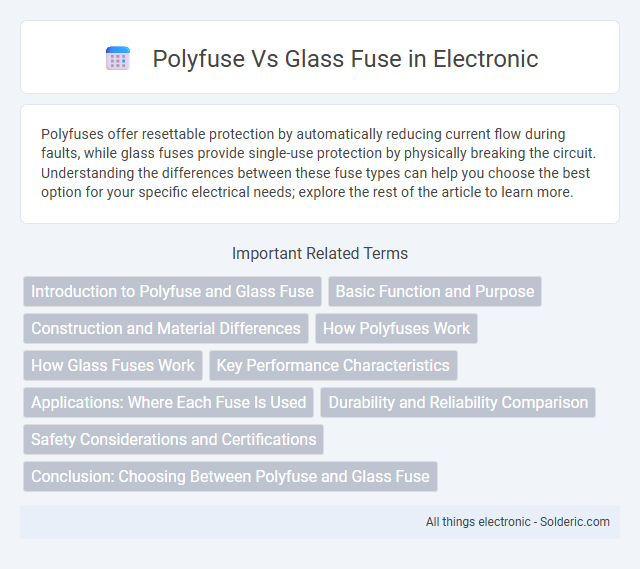Polyfuses offer resettable protection by automatically reducing current flow during faults, while glass fuses provide single-use protection by physically breaking the circuit. Understanding the differences between these fuse types can help you choose the best option for your specific electrical needs; explore the rest of the article to learn more.
Comparison Table
| Feature | Polyfuse | Glass Fuse |
|---|---|---|
| Type | Resettable PTC Fuse | One-time Blown Fuse |
| Material | Polymer-based PTC Thermistor | Glass tube with metal wire |
| Operation | Resets after overcurrent removal | Must be replaced after blowing |
| Response Time | Slower, thermal trip | Faster, melts instantly on overcurrent |
| Current Range | Low to medium currents (typ. 50mA-10A) | Wide range, from mA to 20A+ |
| Typical Applications | Consumer electronics, resettable protection | Industrial, automotive, high current circuits |
| Reset Capability | Yes, automatic reset | No, manual replacement needed |
| Physical Size | Compact, surface mount or through-hole | Varies, typically larger glass tube |
| Cost | Moderate, reusable | Low per unit, single use |
| Failure Indication | No visible indication | Visible fuse element break |
Introduction to Polyfuse and Glass Fuse
Polyfuses are resettable electronic protection devices that limit current flow by increasing resistance when excessive current passes through, while glass fuses are single-use safety devices that permanently break the circuit by melting a metal filament. Polyfuses are favored in applications requiring automatic recovery after fault conditions, offering reusable protection without replacement. Glass fuses provide reliable and precise overcurrent protection in low-voltage circuits but must be replaced once blown to restore functionality.
Basic Function and Purpose
Polyfuses and glass fuses both serve as protective devices in electrical circuits by interrupting current flow during abnormal conditions, but they operate differently. Polyfuses are resettable polymer-based devices that increase resistance when overheating occurs, automatically restoring normal function after cooling down. Glass fuses, on the other hand, contain a metal wire that melts when current exceeds a specific threshold, requiring replacement after each blowout to protect your equipment.
Construction and Material Differences
Polyfuses are constructed using polymer-based materials that offer resettable current protection by increasing resistance when heated, while glass fuses contain a metal wire encased in a glass tube designed to melt and break the circuit during overcurrent. The polymer material in polyfuses allows them to self-recover without replacement, unlike glass fuses which require physical replacement after blowing. Your choice between these components depends on whether you prefer a reusable resettable fuse or a single-use fuse with fast and visible failure indication.
How Polyfuses Work
Polyfuses, also known as resettable fuses, operate by increasing resistance when excess current flows through them, effectively limiting current and protecting circuits from overcurrent conditions. Unlike glass fuses that physically blow and need replacement, polyfuses automatically reset when the fault condition is removed and the device cools down. This makes polyfuses ideal for applications requiring reusable overcurrent protection and reduced maintenance.
How Glass Fuses Work
Glass fuses consist of a thin metal wire enclosed in a transparent glass tube, which melts when excessive current flows through, interrupting the circuit to protect devices from damage. The transparent glass allows easy visual inspection to determine if the fuse has blown. Your electronics remain safeguarded because glass fuses provide reliable overcurrent protection by breaking the circuit precisely when needed.
Key Performance Characteristics
Polyfuses exhibit self-resetting protection by increasing resistance under excessive current, enabling reusable overcurrent defense without replacement, whereas glass fuses provide one-time protection by physically melting upon overload, resulting in circuit interruption. Polyfuses typically have slower response times and higher resistance compared to glass fuses, which offer fast blow characteristics and minimal voltage drop during normal operation. The choice between polyfuse and glass fuse depends on specific application requirements such as reset capability, response speed, and ease of maintenance.
Applications: Where Each Fuse Is Used
Polyfuses are commonly used in low-voltage electronic devices like computers, smartphones, and battery packs for overcurrent protection due to their resettable nature. Glass fuses find applications in household appliances, automotive systems, and industrial equipment where a one-time, reliable interruption of current is critical. Your choice depends on whether you need a fuse that can automatically reset after fault clearance or a single-use fuse that ensures permanent protection.
Durability and Reliability Comparison
Polyfuses offer superior durability under repeated overcurrent conditions due to their self-resetting capability, which prevents permanent damage and maintains circuit protection over multiple events. Glass fuses provide high reliability in single-use scenarios by delivering precise and consistent blow characteristics, but they require replacement after a single fault, impacting their long-term durability. The choice between polyfuse and glass fuse depends on the application's demand for resettable protection versus one-time fail-safe operation.
Safety Considerations and Certifications
Polyfuses offer enhanced safety by providing resettable overcurrent protection, reducing fire hazards compared to single-use glass fuses. Glass fuses, while reliable for precise current interruption, may pose risks if replaced improperly, lacking the self-resetting feature found in polyfuses. Certifications such as UL and IEC standards ensure both types meet stringent safety requirements, but polyfuses often comply with additional certifications for automotive and consumer electronics due to their reusable nature.
Conclusion: Choosing Between Polyfuse and Glass Fuse
Polyfuses offer resettable protection ideal for devices requiring repeated overcurrent defense, while glass fuses provide a one-time, reliable break for high current fault situations. Your choice depends on whether you prioritize reuse and automatic recovery or a clear physical indication of fuse failure. Polyfuses suit electronics with frequent power fluctuations, whereas glass fuses fit applications where fast and definitive disconnection is critical.
polyfuse vs glass fuse Infographic

 solderic.com
solderic.com